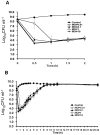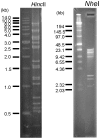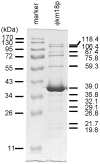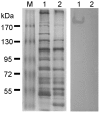Isolation and characterization of φkm18p, a novel lytic phage with therapeutic potential against extensively drug resistant Acinetobacter baumannii
- PMID: 23071586
- PMCID: PMC3465330
- DOI: 10.1371/journal.pone.0046537
Isolation and characterization of φkm18p, a novel lytic phage with therapeutic potential against extensively drug resistant Acinetobacter baumannii
Abstract
Aims: To isolate phages against extensively drug resistant Acinetobacter baumannii (XDRAB) and characterize the highest lytic capability phage as a model to evaluate the potential on phage therapy.
Methods and results: Eight phages were isolated from hospital sewage and showed narrow host spectrum. Phage φkm18p was able to effectively lyse the most XDRAB. It has a dsDNA genome of 45 kb in size and hexagonal head of about 59 nm in diameter and no tail. Bacterial population decreased quickly from 10(8) CFU ml(-1) to 10(3) CFU ml(-1) in 30 min by φkm18p. The 185 kDa lysis protein encoded by φkm18p genome was detected when the extracted protein did not boil before SDS-PAGE; it showed that the lysis protein is a complex rather than a monomer. Phage φkm18p improved human lung epithelial cells survival rates when they were incubated with A. baumannii. Combination of phages (φkm18p, φTZ1 and φ314) as a cocktail could lyse all genotype-varying XDRAB isolates.
Conclusion: Infections with XDRAB are extremely difficult to treat and development of a phage cocktails therapy could be a therapeutic alternative in the future. Phage φkm18p is a good candidate for inclusion in phage cocktails.
Conflict of interest statement
Figures






Similar articles
-
Genomic and Biochemical Characterization of Acinetobacter Podophage Petty Reveals a Novel Lysis Mechanism and Tail-Associated Depolymerase Activity.J Virol. 2018 Feb 26;92(6):e01064-17. doi: 10.1128/JVI.01064-17. Print 2018 Mar 15. J Virol. 2018. PMID: 29298884 Free PMC article.
-
Isolation and characterization of ZZ1, a novel lytic phage that infects Acinetobacter baumannii clinical isolates.BMC Microbiol. 2012 Jul 28;12:156. doi: 10.1186/1471-2180-12-156. BMC Microbiol. 2012. PMID: 22838726 Free PMC article.
-
Efficacy of newly isolated and highly potent bacteriophages in a mouse model of extensively drug-resistant Acinetobacter baumannii bacteraemia.J Glob Antimicrob Resist. 2019 Dec;19:255-261. doi: 10.1016/j.jgar.2019.05.005. Epub 2019 May 14. J Glob Antimicrob Resist. 2019. PMID: 31100499
-
Specific and Selective Bacteriophages in the Fight against Multidrug-resistant Acinetobacter baumannii.Virol Sin. 2019 Aug;34(4):347-357. doi: 10.1007/s12250-019-00125-0. Epub 2019 May 15. Virol Sin. 2019. PMID: 31093881 Free PMC article. Review.
-
Efficacy of φkm18p phage therapy in a murine model of extensively drug-resistant Acinetobacter baumannii infection.Infect Drug Resist. 2018 Nov 15;11:2301-2310. doi: 10.2147/IDR.S179701. eCollection 2018. Infect Drug Resist. 2018. PMID: 30532563 Free PMC article. Review.
Cited by
-
Antibiotic Resistance Profiles, Molecular Mechanisms and Innovative Treatment Strategies of Acinetobacter baumannii.Microorganisms. 2020 Jun 21;8(6):935. doi: 10.3390/microorganisms8060935. Microorganisms. 2020. PMID: 32575913 Free PMC article. Review.
-
How Phages Overcome the Challenges of Drug Resistant Bacteria in Clinical Infections.Infect Drug Resist. 2020 Jan 7;13:45-61. doi: 10.2147/IDR.S234353. eCollection 2020. Infect Drug Resist. 2020. PMID: 32021319 Free PMC article. Review.
-
Characterization and Detection of Endolysin Gene from Three Acinetobacter baumannii Bacteriophages Isolated from Sewage Water.Indian J Microbiol. 2014 Dec;54(4):383-8. doi: 10.1007/s12088-014-0472-x. Epub 2014 May 21. Indian J Microbiol. 2014. PMID: 25320435 Free PMC article.
-
Encapsulation and Delivery of Therapeutic Phages.Appl Environ Microbiol. 2021 Mar 1;87(5):e01979-20. doi: 10.1128/AEM.01979-20. Epub 2020 Dec 11. Appl Environ Microbiol. 2021. PMID: 33310718 Free PMC article. Review.
-
Isolation and characterization of glacier VMY22, a novel lytic cold-active bacteriophage of Bacillus cereus.Virol Sin. 2015 Feb;30(1):52-8. doi: 10.1007/s12250-014-3529-4. Epub 2015 Feb 2. Virol Sin. 2015. PMID: 25680445 Free PMC article.
References
-
- Cisneros JM, Rodriguez-Bano J, Fernandez-Cuenca F, Ribera A, Vila J, et al. (2005) Risk-factors for the acquisition of imipenem-resistant Acinetobacter baumannii in Spain: a nationwide study. Clin Microbiol Infect 11: 874–879. - PubMed
-
- Garnacho-Montero J, Amaya-Villar R (2010) Multiresistant Acinetobacter baumannii infections: epidemiology and management. Curr Opin Infect Dis 23: 332–339. - PubMed
-
- Karageorgopoulos DE, Falagas ME (2008) Current control and treatment of multidrug-resistant Acinetobacter baumannii infections. Lancet Infect Dis 8: 751–762. - PubMed
Publication types
MeSH terms
Substances
LinkOut - more resources
Full Text Sources
Medical

